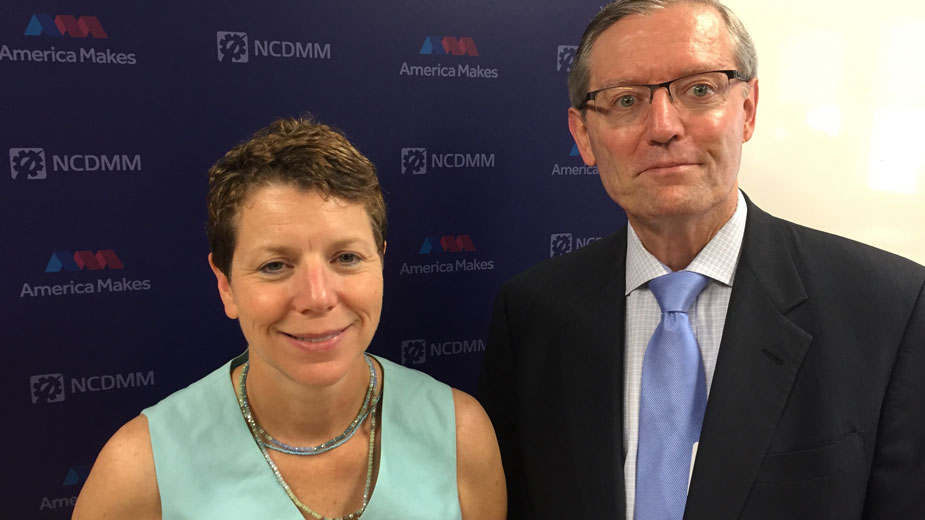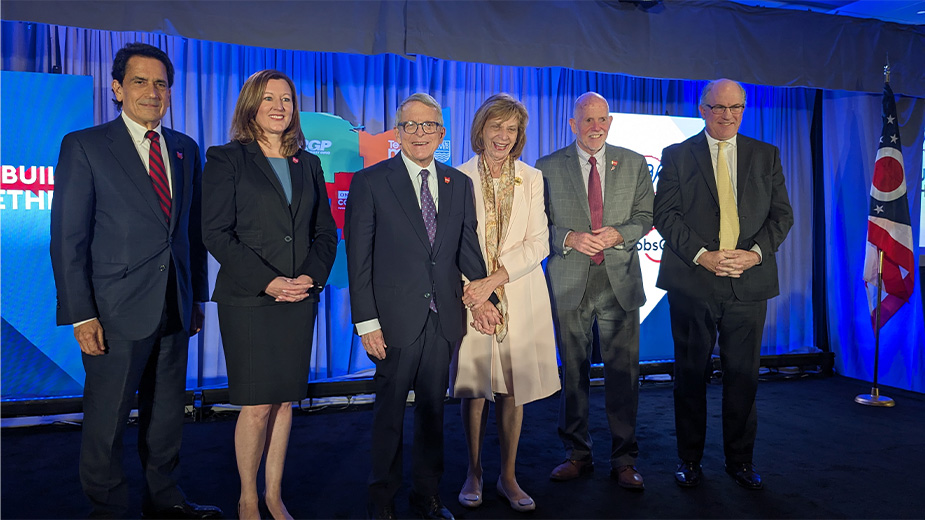Work Begins to Build Additive Manufacturing Cluster
YOUNGSTOWN, Ohio – Now that many of the players and challenges related to developing an additive manufacturing cluster in northeastern Ohio have been identified, the next step is to execute a strategy to attract businesses that supply, use and provide services for this technology.
“We’re looking to build a formal a steering committee and break out into smaller topic areas,” Barb Ewing, chief operating officer at the Youngstown Business Incubator, said Tuesday. “We’ve got to formalize the structure and engage with our organizations.”
Ewing joined Timothy Fahey, vice president of Team Northeast Ohio, or Team NEO, to present the main points of a study that identifies the gaps and opportunities in the value chain associated with accelerating research and developing additive manufacturing in northeastern Ohio.
The study was conducted by the YBI, Team NEO, America Makes: The National Additive Manufacturing Innovation Institute, and Magnet. The study was presented at America Makes.
It identified 165 companies in 18 counties in northeastern Ohio that have some association with, or are using, additive manufacturing, Fahey said. These companies include materials manufacturers, parts producers, research and development organizations, processors, engineering and design firms and suppliers.
The market, however, could be much larger and the opportunity for growth equally as great, Fahey said.
Northeastern Ohio, however, is home to 2,000 companies in the metals manufacturing, plastics and rubber processing sectors, the prime target markets for additive manufacturing technology, he said
Additive manufacturing, or 3-D printing, is a process that uses a software-driven automated process to dispense materials — liquid metals or polymers, for example – and build a part or component from the bottom up. The process eliminates waste and could save manufacturers money in tooling or through producing parts in lower volumes.
Last year, revenues from additive manufacturing’s primary global market increased 25.9% to $5.2 billion, Fahey reported. In North America, revenues could be as much as $1.9 billion, he said.
The total market in the United States for plastics, polymers and metals manufacturing stands at roughly $730 billion, while the available market in northeastern Ohio could be about $17 billion. By 2020, the market potential for tooling alone could be about $1 billion in the region, he said.
“This is to develop a commercialization roadmap,” Fahey stated. “This is a sector with outstanding growth potential.”
The study surveyed more than 50 companies and requested their leaders’ thoughts on what they would like to see develop in additive manufacturing technology, the challenges of creating such a technology cluster here, and any recommendations or outcomes.
“We wanted to investigate OEMs [original equipment manufacturers] and interviewed a number of people who want to use additive manufacturing,” Fahey said.
Among the gaps discovered across northeastern Ohio is the availability and cost of materials, Fahey said. Most companies that contract with a 3-D printer manufacturer are usually bound to purchasing supplies from that same manufacturer, creating a closed supply system.
Other challenges include the lack of large system providers or firms dedicated to software development for additive manufacturing, workforce learning curves when employees make the transition from traditional manufacturing methods to additive, the high capital costs associated with the technology, and the lack of general knowledge among companies on how this technology could help their business or industry.
However, Fahey points out, these gaps reveal great opportunities for the region, noting that the area has the basic resources to become competitive in each of these segments. He pointed out that the region’s high schools, colleges, and universities have begun to offer STEM programs that feature elements of additive manufacturing.
Companies that produce or use tooling and fixtures are in a strong position to capitalize on additive manufacturing in the short term, he said, noting that prototyping is the most common use of the technology today. But companies can reduce such costs by manufacturing tools through 3-D printing rather than the more traditional methods.
The region also has a strong history of materials manufacturing and turning out strong engineering talent capable of supporting additive manufacturing technology, Fahey noted. Plus, research and development in additive manufacturing continues at YSU, America Makes, the University of Akron, and Case Western Reserve University in Cleveland.
“There are tremendous assets in the region in additive manufacturing,” he said.
Production of direct parts in industries such as aerospace can benefit from additive manufacturing technology as well, Fahey said, although he qualified that larger aerospace concerns are more likely to conduct additive operations in-house rather than subcontract the work out to suppliers.
And, competition is intensifying across the country when it comes to attracting companies that manufacture, supply, or engage in research related to additive manufacturing equipment or technology, Fahey said. That means northeastern Ohio must expand its marketing reach – not just across the United States – but the world.
“Recently, several European companies located some of their operations to Michigan,” he said. “We need a better marketing initiative.”
Ewing said that the goals and recommendations call for leveraging the expertise of America Makes and the tech belt region to compete effectively with other areas to develop an additive manufacturing cluster, establish programs to integrated additive manufacturing technology into the existing manufacturing base, and to expand additive manufacturing curricula within K-12 and post-secondary education.
“In South Korea they’re investing $10 million a year – the goal is to have one-fifth of the population trained in additive manufacturing,” Ewing said. “We don’t want to be behind the curve.”
Other goals are to build a supply network in key markets such as the automotive, biomedical and aerospace industries as well as establish a framework to foster entrepreneurship and commercialization of additive manufacturing technologies.
“This would be for the high-end, and the small, mom-and-pop shops – the maker spaces,” she noted. “We need to get people to think differently. This is about us collectively identifying the assets and developing the best programs in the world.”
Pictured: Barb Ewing and Timothy Fahey.
Copyright 2024 The Business Journal, Youngstown, Ohio.



